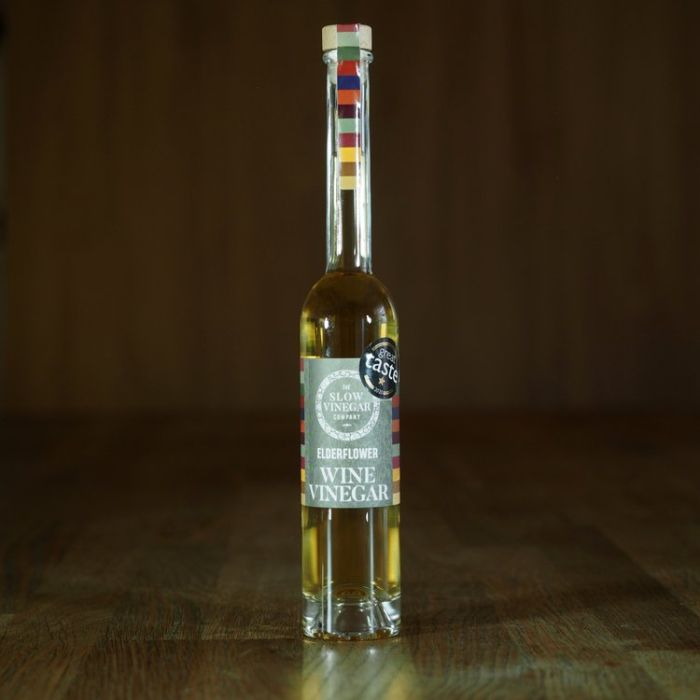
Elderflower Wine Vinegar - 100ml
Currently based just outside Frome in Corsley, Wiltshire, The Slow Vinegar Company was started as a way of channelling creativity and interest in food culture into the production of a traditional food staple—vinegar.
This Great Taste Award winning vinegar has a delicate acidity with a floral sweetness. The flavour is bright and zingy and nicely rounded. Add to gin, cordial, and sparkling water for a refreshing cocktail. It makes a lovely salad dressing and can be spritzed over roast vegetables. Also great drizzled on ice cream.
Acidity 5%
A little more detail…
After picking 100’s of beautiful elderflower heads in May and June, we then ferment and craft over the next year to create a vinegar that has a delicate floral sweetness.
One of the more majestic of hedgerow trees is the Elder, flowering with beautiful strong scented creamy white umbels in June and yielding fruity berries in the autumn. Picking the flowers is always a pleasure to do on evening walks in late Spring when the days are nearly at their longest. The flavour of Elderflower is well established often used in drinks and as a delicate floral addition for desserts.
Elderflower Champagne is something we make every year, a simple recipe handed down over generations, but the making of Elderflower Wine is one of the most satisfying fermentations. The flowers are full of natural yeasts and sugars which seem to make it fizz vigorously. Elderflower Wine Vinegar will be a ‘go to’ in your kitchen for summer salad dressings, and fish marinades, as well as a little shot to pep up your drinks.
Quick tips
- add a tsp or two to your gin and tonic
- mix with oil, garlic and thyme for a great lamb marinade
- mix with oil and English mustard for a fresh dressing
Recipe Idea
Marinade for Lamb steaks (or Tuna)
-
4 tbsp Elderflower Vinegar
-
6 tbsp Rapeseed or Olive Oil
-
1 tbsp Dijon mustard
-
3 cloves of garlic chopped
Mix all the ingredients together, place in a bag or container and give a good squish around. Leave in fridge for a few hours or overnight if possible. Remove the steaks (make sure to scrape off the garlic bits as they will burn and taste bitter if left on).
Griddle, fry or BBQ until cooked to your liking.
Best Before - Use By Dates - Vinegar Storage
We all understand that Best Before labelling is a vital part of food production, in place to protect the consumer.
Vinegar, however, is a preservative and as such doesn't need to display Use By or Best Before information. In the EC1169/2011 directive which applies to Food Labels, Vinegar is an exempt product for the purposes of marking an expiry date.
This information became clear to us after we had printed some bottle labels. Consequently some of our bottles carry the text BBE (Best Before End) and a mark on their neck—2 years from purchase date.
It is safe to say though that our vinegars will only mature and improve with age. The cost of some of the most expensive vinegars available is often based around its age.
The one thing that does affect vinegar is exposure to air. This is why they are traditionally bottled in narrow bottles in order to reduce the surface area in contact with the air. While unopened bottles will last and improve, open bottles will react to exposure to air. Over time flavours will fade, so our advice is to keep using the vinegars once they are opened.
Storage is best in cool, dark conditions.
Mother of vinegar
There is a lot written about the Mother of vinegar and its presence within vinegar making processes. Basically, when alcohol ferments into vinegar, the Mother of vinegar is driving this change. The Acetobacter aceti, (good bacteria and proper name for the Mother), responsible for this transformation / fermentation, are present naturally and controlling them in our production process is one of our challenges. While Mother of vinegar is the common name given to the acetobacter, it can appear in a more cp955_visible form as a gelatinous disk floating on the surface of fermenting alcohol / vinegar. Comprising primarily of cellulose, it is harmless if accidentally consumed, but not recommended!
The Mother of vinegar is present in all our vinegars as we don’t use any pasteurising process which would kill the acetobacter. Because the vinegars contain ‘live’ bacteria, occasionally a small jelly like disk may form on the surface of the vinegar in the bottle. As already mentioned, this is harmless and can easily be removed, discarded or ignored. The rest of the vinegar does not need to be discarded.
Nutrition
Trading standards and the regulations surrounding food labelling are strict and well regulated. Usually and for good reason, packaged foods need to display their nutritional values.
Fermented vinegars are exempt from the need to display nutritional values on their packaging. However, we have gone to the trouble of obtaining this level of analysis on our vinegars so you can be sure about their cp955_contents.
| Energy (kJ/100ml (kcal/100ml)) | 78 (18) |
| Fat (g/100ml) | <0.5 |
| —of which saturates (g/100ml) | <0.5 |
| Carbohydrate (g/100ml) | <0.5 |
| —of which sugars (g/100ml) | <0.5 |
| Protein (g/100ml) | <0.5 |
| Salt (g/100ml) | <0.01 |
